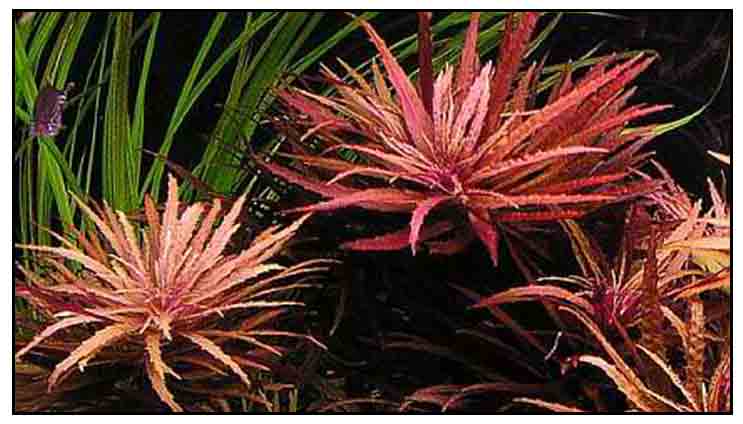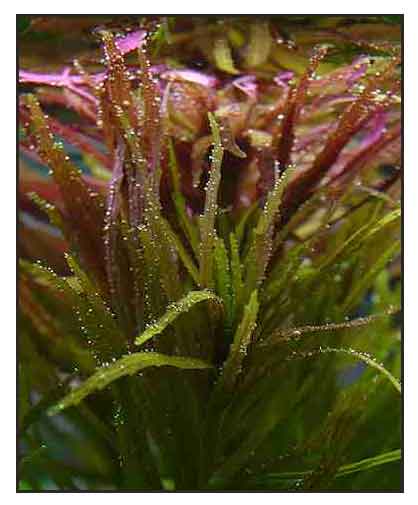
Botany
Añgañgi is a smooth herb that grows in water or marshy places. Stems are stout, erect, simple, 30 to 60 centimeters in length, and rarely branched above. Leaves are linear-oblong or oblong-lanceolate, 2 to 6 centimeters in length, 0.5 to 1 centimeter in width, opposite and whorled, with pointed tip, rounded and clasping base, and toothed margins. Flowers are pink or pale purple, and borne singly or in whorls in inflorescences at the axils of the leaves, with long, very slender pedicels 1 to 1.5 centimeters long. Calyx is about 4 millimeters long, glandular, and divided into lanceolate segments. Corolla is 1.2 centimeters long. Capsules are oblong and pointed at the tip.
 Distribution Distribution
- In marshes and open wet places at low and medium altitudes, ascending to 1,600 meters.
- Found in Ilocos Norte, Bontoc, Benguet, Nueva Viscaya, and Camarines Provinces in Luzon; in Palawan, Polilo and Mindanao.
Occurs in India to Taiwan and southward through Malaya to tropical Australia.
Constituents
- Analysis of essential oil showed the major components were limonene (15.09%), (+)-trans-isolimonene (14.52%) and α-humulene (6.04%). (see study below) (1)
- Studies have isolated about 54 phytochemicals, mostly terpenoids, phenolics, and flavonoids. (16)
- Other oil constituents are perillaldehyde and a monoterpenoid ketone, cis-4-caranone.
- In a study of 5 edible wild plants for vitamin composition, phenolic and flavonoid content, Limnophila aromaticoides (finger grass) yielded: (Vitamins/ µg/g FW) ascorbic acid 844.6 ± 7.3, y-tocopherol 7.0 ±1.2, α-tocopherol 14.8 ±0.4, thiamin 16.6 ±0.1, riboflavin 13.7 ± 0.0; (Antioxidant components) total phenolic (mg GAE/g FW) 3.8 ±0.1, total flavonoid (mg RE/g FW) 1.3 ±0.0; (EC50 value: mg extract/ml) DPPH radical scavenging ability 2.8±1.58, ferrous ion chelating ability 10.80±0.25. (12)
- In a study of leaf essential oil, methyl benzoate (27.7%), pulegone (23.4%) and limonene (20.2%) were the significant compounds of L. aromatica.
(13)
- Study of leaf ethanol extract yielded: (phytochemicals) essential oils, terpenoids, saponins, tannins.
(14)
- Study of essential oil yielded a total of 36 volatile organic constituents. Analysis revealed the presence of only seven major volatile compounds viz., amyl vinyl carbinol, terpinolene, ß-linalool, sabinene, terpinen-4-ol, α-humulene, and aromadendrene in the range of 3.02% to 30.06%. Volatiles can be grouped into monoterpene (44.10%), oxygenated monoterpene (32.15%), sesquiterpene (20.87%), oxygenated sesquiterpene (1.2%) and oxygenated diterpene (2.27%-1.51%). (see study below) (18)
Properties
- Plant emits a turpentine-like odor.
-
Sour, slightly bitter.
-
Considered antiseptic, aperient, appetizer, digestive, carminative, anthelmintic, anti-inflammatory, diuretic, cooling, emollient, febrifuge, galactagogue.
- Studies have shown antioxidant, antimicrobial, anti-inflammatory, hemolytic, cytotoxic, mood state relaxing activities.
Parts used
Whole plant, leaves, roots.
Uses
Edibility
- Plant used as spinach, eaten raw or steamed.
- Herb has an intense lemon-like flavor.
- In Java, plant is eaten raw or steamed; thought to be good for quieting the stomach after eating durian.
- A popular culinary herb in Vietnamese cuisine.
- Used in all traditional Cambodian soup dishes.
Folkloric
- Leaves are used for poulticing sores on legs.
- Decoction of leaves and roots given for fevers.
- Plant used as a cooling medicine for fevers.
- Used by nursing mothers when their milk is sour; also used as a galactagogue.
- In Ayurveda, used in vitiated conditions of pitta. Also used for foul ulcers, agalactia, galactic impurities, anorexia, dyspepsia, helminthiasis, constipation, inflammations and strangury.
- Plant juice used as cooling medicine for fever and pharyngitis.
Studies
• Antioxidant: Study of the antioxidant properties of a methanol extract, essential oil and related compounds showed the methanol extract and essential oil exhibiting free radical scavenging, NO radical scavenging and antilipid peroxidation. However, both showed less potent antioxidant activity than the reference compounds, torlox and curcumin. (see constituents) (1)
• Antioxidant / Vascular Protective: Study of three popular Thai dietary and herbal plants, Cratoxylum formosum, Syzygium gratum and Limnophila aromatica for antioxidant and vascular protective activities in in vitro and in vivo models showed the plant extracts to possess antioxidants and have potential roles in prevention of vascular dysfunction. (2)
• Antimicrobial: Study of L. aromatica extract showed antimicrobial activity against B. cereus, Listeria monocytogenes, Pseudomonas fluorescens, S. typhimurium, S. aureus and Yersinia enterocolitica. The activity may be attributed to its essential oil consisting of limonene and peril-aldehyde as major compounds, flavone, and flavonoids. (4)
• Volatile Oil Constituents / Aerial Parts: Study of essential oil isolated from the aerial parts of L. aromatica yielded 29 components representing 99.3% of the total oil. The oil was rich in Z-ocimene (39.2%), terpinolene (17.2%) and camphor (12.9%). (5)
• Anti-Inflammatory: Study of anti-inflammatory activity of extracts of 13 Thai spices/herbs with lipopolysaccharide-activated RAW 264.7 murine macrophages showed the extract from L. aromatica to be the most robust dose-dependent suppression of NO production without exerting cytotoxicity. L. aromatica extract also showed the greatest inhibition of TNF-alpha production (IC50 10.5 mcg/ml). (6)
• Antioxidant / Antimicrobial: Study screened 20 Thai plants, a methanolic extract of C. siamea, Limnophilia aromatica, and Pl odoratum exhibited strong antioxidant and antimicrobial activities. (8)
• Antioxidant / Phenolic and Flavonoid Content: Study evaluated various extracts of freeze dried L. aromatica for antioxidant activity, total phenolic content, and total flavonoid content. A 100% ethanol extract showed the highest antioxidant activity, reducing power and DPPH radical scavenging activity. The extract also showed the highest phenolic content (40.5 mg gallic acid equivalent/ g of defatted L. aromatica) and the highest flavonoid content (31.11 mg quercetin equivalent/g of defatted L. aromatica). (11)
• Antioxidant / Leaves: Study of ethanol leaf extract showed a phenolic content of 152.41±14.20 µg GAE/mg and a flavonoid content of 112.35±0.50 µg CAE/mg. Antioxidant activity on various assays showed: DPPH 24.44±0.30 EC50 µg/ml; LPO inhibition 17.58±1.04 EC50 µg/ml; FRAP 2.30±0.12 µmol Fe/mg. (14)
• Cytotoxicity / n-Lymphocytes and Cancer Cell Lines / Leaves: Study on cytotoxicity effects on n-lymphocytes and 3-cancer cell lines showed: n-lymphocyte >400; (cancer cell lines) Jurkat 128.60 (109.30-151.30), MCF7 291.70 (270.70-315.70), and HepG2 349.90 (316-393.60). (14)
• Hemolytic Activity on Human Erythrocytes / Leaves: Study of leaf extract on human erythrocytes showed % hemolysis: (200 µg/ml) 0.90±0.11, (400 µg/ml) 1.50±0.41, (600 µg/ml) 6.08±0.99, (1200 µg/ml) 22.78±5.93, (EC50 µg/ml) >1200. (14)
• Anti-Inflammatory: In a study 10 local Thai vegetables fr analgesic (writhing test and tail flick test) and anti-inflammatory (rat hind paw edema model) activities, Limnophila aromatica was one of seven that showed significant inhibition on writhing reflex. (15)
• Antioxidant: In a study of various extracts for antioxidant activity, total phenolic, and total flavonoid content using in vitro assays, a 100% ethanol extract showed highest total antioxidant activity, reducing power and DPPH radical scavenging activity. Same extract yielded highest phenolic content (31.11 mg QEC/gm extract; while a 50% aqueous extract gave highest extraction yield. Study suggest potential dietary application to reduce oxidative stress. (16)(17)
• Volatile Hydrocarbons / Possible Chemotaxonomic Marker: Study of essential oil yielded a total of 36 volatile organic constituents. The presence of sabinene, terpinen-4-ol and α-humulene in high percentages suggested use as chemotaxonomical markers of the herbs. (see constituents above) (18)
• Effect on Brain Wave Activities and Emotional States / Inhaled Essential Oil Clinical Trial: Randomized crossover study evaluated the effects of inhaled L. aromatica essential oil on brain wave activities using EEG recordings and emotional states among healthy volunteers. The essential oil was extracted from aerial parts. Results showed Limnophila aromatica essential oil increased theta and alpha wave and induced more relaxed feelings compared to the vehicle. Study suggests inhalation of the EO could cause relaxing effects on positive mood states and the relaxation of brain state. (19)
• Starch Source: Starch is one of the digestible polymers found in vascular plants. Natural polymer is the primary source of polysaccharides that produce energy for humans. Study reports on the extraction of starch from defatted and dephenolated L. aromatica using the alkaline method. The starch showed a purity of 70.43% where 55.1% is resident starch. Results showed the starch from DFP:LA possesses good physicochemical properties and has potential as an alternative starch with application as a new feedstock for food industries. (20)
• Effect of Drying Method on Antioxidant Capacity: Study evaluated the effect of air-drying on antioxidant capacity of L. aromatica. At 40°C the antioxidant capacity decreased the most. The drying temperature at 50°C was suitable for convection drying and 60·°C was suitable and drying temperature at 60°C was suitable for vacuum drying. Freeze drying was effective for retaining antioxidant capacity. Over six weeks of preservation the dried product showed deterioration in antioxidant properties. (21)
• Microwave Extraction of Essential Oil: Study reported on the solvent-free microwave extraction (SFME) conditions for the recovery of essential oil from Limnophila aromatica. The optimal SFME process conditions for achieving the maximal essential oil yield were 700W for 25 min. The most important variable influencing oil recovery was the irradiation time (p<0.001), followed by the microwave power (p<0.01). The applied extraction method offered essential oil yields during the different seasons ranging from 0.20 % to 0.24 % (v/w). The obtained essential oils showed the presence of forty-seven constituents. mainly limonene, perillaldehyde, (E)-4-caranone, (Z)-4-caranone, and α-pinene. Monoterpene hydrocarbons were the dominant class of compounds in the oils. Results are useful for identifying eco-friendly essential oil extraction conditions and also serve as a useful guide for informing agronomic practices during the planting and cultivation of the studied medicinal plant. (22)
Availability
Wild-crafted.
|

![]()




 Distribution
Distribution